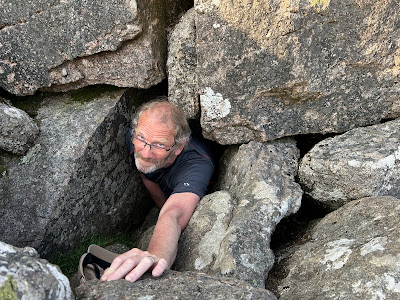I am, you are, we are, crazy!
I am, you are, we are, crazy!
Hey Pete, you gotta meet the Pot-Head Pixies
I am, you are, we are, crazy!
So meet, you'll never beat the Pot-Head Pixies
I am, you are, we are, crazy!
Oh me, they're something to see, the Pot-Head Pixies
I am, you are, we are, crazy!
Oh my come from the sky, the Pot-Head Pixies
I am, you are, we are, crazy!"
Daevid Allen (1973)
Although the overnight forecast had been for an open sky with an accompanying severe drop in temperature, yesterday evening I put the moth trap out again for the second night in a row, hoping to improve on the first night’s catch.
When the alarm went off at 4:30AM this morning I groped around in the dark of the unfamiliar bedroom, trying not to wake A in the process. On leaving the cottage, I flushed a pair of Mallard (Anas platyrhynchos) from the garden pond (I am still not sure who jumped the most - myself or the ducks?). Out on the moor a Cuckoo (Cuculus canorus) called repeatedly into the still morning.
I barely looked in the moth trap, simply noting that it looked like another meagre haul. I covered it up with the groundsheet – before heading back to bed.
Later, sorting through the egg trays I was chuffed to turn out an Eyed Hawk-moth (Smerinthus ocellata) a species that I have only seen once before, maybe some 15 years or so ago – when I had chanced upon a specimen lying in the middle of a pavement on a busy street in Southsea. I had picked the moth up and put it in some foliage atop the garden wall of the local Mosque.
 |
| Eyed Hawk-moth |
Moth trap; 20W actinic heath trap:
1 x Eyed Hawk-moth
2 x Treble Lines (Charanyca trigrammica)
2 x Flame Shoulder (Ochropleura plecta)
1 x Common Cockchafer (Melolontha melolontha)
2 x Caddisfly (unidentified)
 |
| Common Cockchafer |
With supplies running low, we drove into Tavistock mid-morning, stocking up on food, beer, and wine. At FatFace we bought long-sleeved linen shirts to cover our sunburnt arms and necks.
Never one to miss an opportunity to peruse an independent bookshop we visited Book Stop in the hope of finding a copy of George Thurlow’s tome “Thurlow’s Dartmoor Companion” (2nd Edition 2001) – a copy of which is in the cottage’s library. It transpired the book is out of print, the shop assistant found a second hand copy available online, wrote the address of the website down for me, and encouraged me to order it directly to our home address, rather than through the shop. Conscientiously saving double postage costs as well as reducing it's carbon footprint.
Not wishing to leave the bookshop empty handed I bought a copy of Paul Rendell’s “Exploring Around Burrator, A Dartmoor Reservoir" (2nd Edition 2023). As well as a couple of free leaflets from swlakestrust describing walks around the Burrator reservoir.
This afternoon, we decided to stretch our legs on the southern flank of Sheepstor, as I was intrigued by an entry in the cottage welcome pack, which referred to the Pixies’ House, and was also annotated on the OS Explorer OL28 as “Piskies or Pixies House”. From the brief write up in the welcome pack, it was a natural cave which at some distant point in the moor’s history had hidden an important man from persecution following some notable historical event? I had barely taken in the detail, and set off in pursuit of the cave, thinking it would be simple enough to find the feature in such a small area.
However, the cave was not easy to locate. I went up and down the slope peering between and under rocks to no avail. At one point I struck out purposefully towards a “large opening” visible just below the tor summit. As I got closer, I had to admit that I was literally chasing a shadow. Much to A’s amusement - who had tagged along to humour me. She waited patiently, as I scoured the rocks for an opening.
Frustrated, I turned to Google, and did an internet search, relieved that I was in full receipt of 4G. Several images flashed up, and it was apparent that I was only some 20m below the rock face which held the cave.
It did not take me long to scramble headfirst into the small hole at the foot of the vertical crack in the boulders. A dutifully took a photograph of me confirming I had survived the ingress.
The cave comprises of a small almost rectangular box, with two low creeps running parallel and away from it for a couple of meters.
Retreating from the confinement, I sat outside and drew a sketch of the rock face in my moleskine, as a reminder, should I ever wish to return to the site.
Shortly afterwards, we were back in the cottage, and taking stock of the Papillon Gin, mixed with Luscombe Grapefruit Tonic Water, and a slice of pink grapefruit. Following the recipe recommended by the helpful shop assistant in Roots and Vines, Tavistock.
Whilst we sat on the patio in the sunshine with our drinks, I flicked through the copy of Thurlow’s Dartmoor Companion (ibid) and discovered that on p.70 there was both a brief description of the cave, and its historical significance - along with a detailed illustration of the rock face, it was under!
Rather than paraphrase here the tale of the cave from Thurlow, I will leave the telling to the Tim Sandles the author of the online gazetteer “Legendary Dartmoor.”
This evening, after sunset I took a simple pleasure in releasing the Eyed Hawk-moth from my hand.








No comments:
Post a Comment